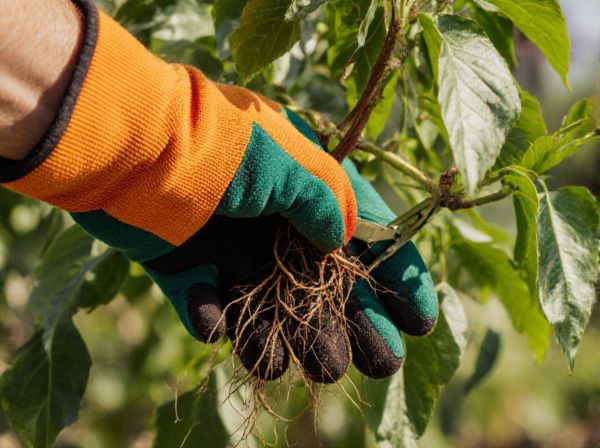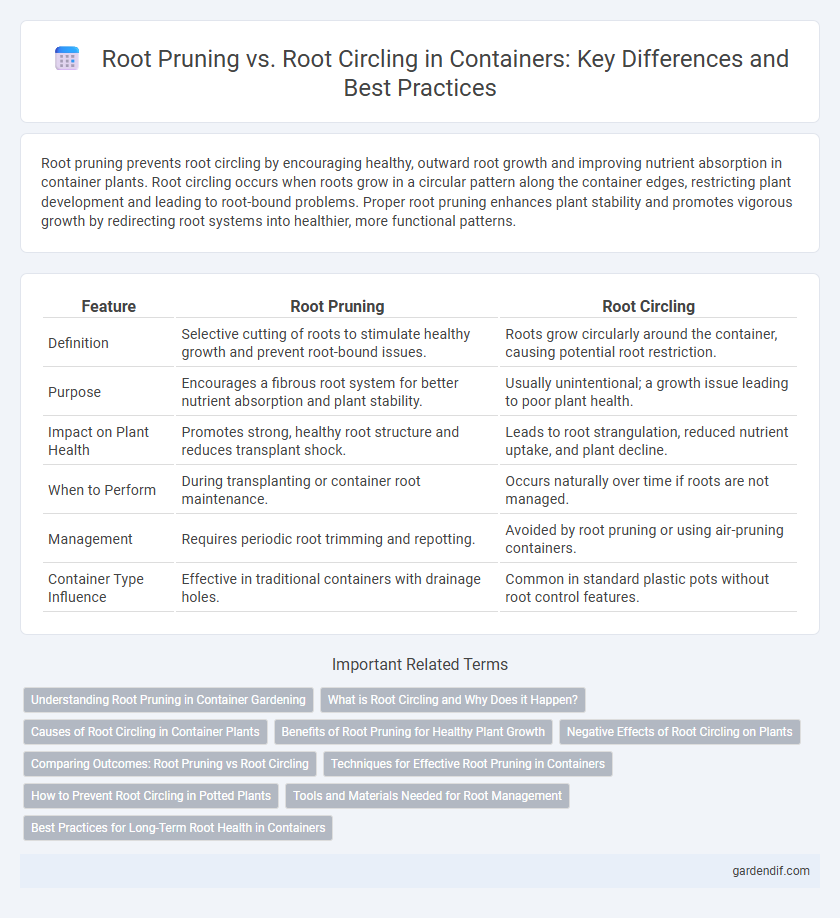
Root pruning vs Root circling Illustration
Root pruning prevents root circling by encouraging healthy, outward root growth and improving nutrient absorption in container plants. Root circling occurs when roots grow in a circular pattern along the container edges, restricting plant development and leading to root-bound problems. Proper root pruning enhances plant stability and promotes vigorous growth by redirecting root systems into healthier, more functional patterns.
Table of Comparison
| Feature | Root Pruning | Root Circling |
|---|---|---|
| Definition | Selective cutting of roots to stimulate healthy growth and prevent root-bound issues. | Roots grow circularly around the container, causing potential root restriction. |
| Purpose | Encourages a fibrous root system for better nutrient absorption and plant stability. | Usually unintentional; a growth issue leading to poor plant health. |
| Impact on Plant Health | Promotes strong, healthy root structure and reduces transplant shock. | Leads to root strangulation, reduced nutrient uptake, and plant decline. |
| When to Perform | During transplanting or container root maintenance. | Occurs naturally over time if roots are not managed. |
| Management | Requires periodic root trimming and repotting. | Avoided by root pruning or using air-pruning containers. |
| Container Type Influence | Effective in traditional containers with drainage holes. | Common in standard plastic pots without root control features. |
Understanding Root Pruning in Container Gardening
Root pruning in container gardening involves selectively cutting roots to prevent root circling, which can restrict nutrient and water uptake. This technique encourages healthier root growth by stimulating new root development and improving soil aeration. Proper root pruning extends plant life and enhances overall container plant vigor.
What is Root Circling and Why Does it Happen?
Root circling occurs when roots grow in a circular pattern inside containers, often caused by limited space and lack of air pruning. This phenomenon restricts nutrient uptake, weakens structural stability, and inhibits healthy root expansion. Identifying root circling early helps prevent plant stress and promotes optimal growth by ensuring proper root development.
Causes of Root Circling in Container Plants
Root circling in container plants primarily results from restricted root space and prolonged growth within a confined container, causing roots to grow in a circular pattern. Poor container design with inadequate drainage or smooth, non-porous walls exacerbates root circling by preventing natural root expansion and air pruning. Overwatering and nutrient imbalances further contribute to root stress, intensifying the tendency for roots to circle rather than establish a healthy, fibrous root system.
Benefits of Root Pruning for Healthy Plant Growth
Root pruning enhances plant health by preventing root circling, which can cause girdling and restrict nutrient uptake. It stimulates the development of a dense, fibrous root system that improves water absorption and supports more uniform growth. Proper root pruning also reduces transplant shock, promoting faster establishment and long-term vigor in container-grown plants.
Negative Effects of Root Circling on Plants
Root circling causes roots to grow in tight, spiraling patterns that restrict nutrient and water uptake, leading to stunted plant growth and poor stability. This abnormal root development increases susceptibility to drought stress and root rot by limiting soil contact. Over time, root circling can result in girdling roots that strangle vascular tissues, severely damaging or killing the plant.
Comparing Outcomes: Root Pruning vs Root Circling
Root pruning promotes healthier root systems by encouraging strong, fibrous root growth that improves nutrient uptake and prevents plants from becoming root-bound. In contrast, root circling occurs when roots grow in tight loops against the container walls, leading to girdling roots that can strangle the plant and reduce long-term stability. The outcome of root pruning is enhanced plant vigor and increased transplant success, whereas root circling often results in poor establishment and diminished growth performance.
Techniques for Effective Root Pruning in Containers
Effective root pruning in containers involves selectively trimming circling roots to prevent root girdling, which can restrict nutrient uptake and stunt plant growth. Techniques include gently removing the root ball from the container, carefully untangling and cutting away encircling roots with sterilized tools, and ensuring the root mass remains balanced to promote healthy root expansion. Proper root pruning increases oxygen availability and encourages the development of new fibrous roots, resulting in improved water absorption and overall plant vigor.
How to Prevent Root Circling in Potted Plants
To prevent root circling in potted plants, select containers with adequate drainage holes and air-pruning features that naturally prune roots by exposing them to air, encouraging healthy root branching. Regularly repot plants into larger containers or use root pruning techniques such as gently trimming the outer roots during repotting to stimulate radial growth rather than root circling. Incorporating well-draining soil mix and avoiding containers that are too large for the plant's root system minimizes waterlogging and reduces the likelihood of root circling.
Tools and Materials Needed for Root Management
Effective root pruning requires sharp pruning shears or a specialized root pruning saw to cleanly cut through woody roots without causing excessive damage. For managing root circling, tools such as a root hook, air spade, or even a root rake are essential to gently tease out and straighten circling roots before replanting. Using high-quality sterilized tools and materials like root hormone powders or mycorrhizal fungi can promote healthy root growth and reduce transplant shock.
Best Practices for Long-Term Root Health in Containers
Root pruning encourages healthy root branching by preventing roots from circling and becoming root-bound, which improves nutrient absorption and overall plant stability. Managing root circling through regular pruning and using air-pruning containers supports long-term root health by promoting a fibrous root system and reducing root rot risk. Consistent monitoring and timely intervention ensure container plants maintain optimal root structure and thrive over extended periods.
Root pruning vs Root circling Infographic

 gardendif.com
gardendif.com